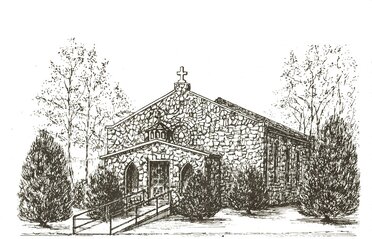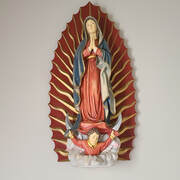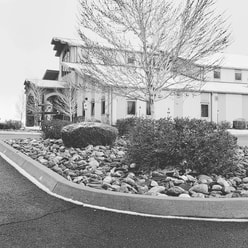The Story and History of Corpus Christi Catholic Community

On the 15 of June, 1949, the Bureau Indian Affairs granted the Catholic Bishop of Reno permission to use an acre of land at the Stewart Indian School in Stewart, Nevada, to use as a mission and school. Later that year, with the help of Native American stone masons Joe Burkeheart and Randy Wungnema, construction commenced on a 2900 square foot building. The design of the new church was by Ferris & Erskine, Architects. By May of next year, the church was ready, and the first mass was celebrated by Bishop T.K. Gorman.
Stone for the church was taken from the Federal quarry east of Carson City. The church owes its unique look to the fact that the inside mortar was mixed with brick dust, and the outside mortar was mixed with coal dust.
From 1950-1968, priests stationed at St. Gall in Gardnerville served Corpus Christi and the church was considered to be part of the parish of St. Gall. Among those serving was Father Labourie. It wasn’t until March of 1968 that Corpus Christi got its first regular priest, Father Bernard Sheerin, S.J., who was also a chaplain for the Nevada State Prison. With Father Sheerin’s arrival, Corpus Christi became affiliated with St. Teresa of Avila in Carson City.
In June of 1968 Father James A. McGrath arrived, becoming the first pastor of the new Corpus Christi parish in 1982. He was joined in 1981 by Father Seamus Hatton as associate pastor.
In 1969 a well and septic system were installed on the property, and nine years later a 1,960 square foot used steel building from Gabbs was erected on the site as the parish hall. In 1979, a double-wide mobile home was purchased as a rectory/office. Previously, Father McGrath lived in a large tool shed, which is now converted as the CCD office!
In 1980, Stewart Indian School closed after 89 years. In September of 1981, the Bureau of Indian Affairs notified Bishop McFarland by letter that their use permit had been revoked. Corpus Christi was given 30 days to vacate the premises!
Bishop McFarland quickly wrote to Secretary of the Interior James Watt, stating that Corpus Christi had been serving the spiritual needs of the community for 32 years. It wasn’t until June of 1983 that Bishop McFarland was able to approve a new $1 a year lease from the Washoe Tribe, good until 2047.
In 1982, Father Timothy Twomey became pastor. In 1986, Father David Casaleggio arrived. In 1987, he oversaw the remodeling of the church, including the installation of a large pipe organ, the money for which was donated by 104 parishioners. In the same year the Grotto was also installed, in memory of Louie Koontz and Jack Callahan. Father Joseph Anthony replaced him in 1988, and Father Thomas Donnelly became pastor in 1989. In 1991, Father Ariel Arias became pastor. An off-site rectory was purchased in 1992, and the former rectory was used solely for administrative purposes. At about this time, the parking lot was also paved, and the hall was remodeled to include a professional kitchen for parish functions.
Stone for the church was taken from the Federal quarry east of Carson City. The church owes its unique look to the fact that the inside mortar was mixed with brick dust, and the outside mortar was mixed with coal dust.
From 1950-1968, priests stationed at St. Gall in Gardnerville served Corpus Christi and the church was considered to be part of the parish of St. Gall. Among those serving was Father Labourie. It wasn’t until March of 1968 that Corpus Christi got its first regular priest, Father Bernard Sheerin, S.J., who was also a chaplain for the Nevada State Prison. With Father Sheerin’s arrival, Corpus Christi became affiliated with St. Teresa of Avila in Carson City.
In June of 1968 Father James A. McGrath arrived, becoming the first pastor of the new Corpus Christi parish in 1982. He was joined in 1981 by Father Seamus Hatton as associate pastor.
In 1969 a well and septic system were installed on the property, and nine years later a 1,960 square foot used steel building from Gabbs was erected on the site as the parish hall. In 1979, a double-wide mobile home was purchased as a rectory/office. Previously, Father McGrath lived in a large tool shed, which is now converted as the CCD office!
In 1980, Stewart Indian School closed after 89 years. In September of 1981, the Bureau of Indian Affairs notified Bishop McFarland by letter that their use permit had been revoked. Corpus Christi was given 30 days to vacate the premises!
Bishop McFarland quickly wrote to Secretary of the Interior James Watt, stating that Corpus Christi had been serving the spiritual needs of the community for 32 years. It wasn’t until June of 1983 that Bishop McFarland was able to approve a new $1 a year lease from the Washoe Tribe, good until 2047.
In 1982, Father Timothy Twomey became pastor. In 1986, Father David Casaleggio arrived. In 1987, he oversaw the remodeling of the church, including the installation of a large pipe organ, the money for which was donated by 104 parishioners. In the same year the Grotto was also installed, in memory of Louie Koontz and Jack Callahan. Father Joseph Anthony replaced him in 1988, and Father Thomas Donnelly became pastor in 1989. In 1991, Father Ariel Arias became pastor. An off-site rectory was purchased in 1992, and the former rectory was used solely for administrative purposes. At about this time, the parking lot was also paved, and the hall was remodeled to include a professional kitchen for parish functions.

In September of 1998, Father James J. Setelik, Jr, was installed as pastor. In 2001 the Hispanic parishioners collected the funds to install a beautiful statue of Our Lady of Guadalupe. During this period, great strides were taken in bringing the Anglo and Hispanic communities together in celebration- attendance at the Corpus Christi Ice Cream Social, Feast of Corpus Christi, and the St Joseph Dinner increased dramatically, probably due at least in part to Fr. Jim’s excellent cooking skills!

Father Jim oversaw the second phase of Corpus Christi Church history with the building of a new church on 7.5 acres in Douglas County, before the new freeway was built and makes it more difficult to access the church. The new location is located at 3597 N. Sunridge Drive, Carson City, NV 89705.
Phase I of the project was completed on March 11, 2009. Furnishings and office staff moved in around May and the parish opened it's doors for the first Mass in July of 2009. Without a sound system, sign and kitchen the new parish center was slow to find her feet! With generous contributions from the Roger Block Family, the kitchen was completed in 2013. We are currently waiting for the second half of the sound system and someday hope to have people be able to find us with a street side sign! Still to be completed...moving of the stained glass windows and pipe organ from the Snyder facility, the rest of the digital sound system and of course in years to come...
the physical church, Corpus Christi is looking forward to the future!
Phase I of the project was completed on March 11, 2009. Furnishings and office staff moved in around May and the parish opened it's doors for the first Mass in July of 2009. Without a sound system, sign and kitchen the new parish center was slow to find her feet! With generous contributions from the Roger Block Family, the kitchen was completed in 2013. We are currently waiting for the second half of the sound system and someday hope to have people be able to find us with a street side sign! Still to be completed...moving of the stained glass windows and pipe organ from the Snyder facility, the rest of the digital sound system and of course in years to come...
the physical church, Corpus Christi is looking forward to the future!

With a generous private donation, the pipe organ was moved in August of 2015. It can now be enjoyed by our parishioners!
The original location on Snyder Ave. was returned to the Washoe Tribe on February 1, 2016, intact.
The altar was removed and all sacred items were moved to the new location.
